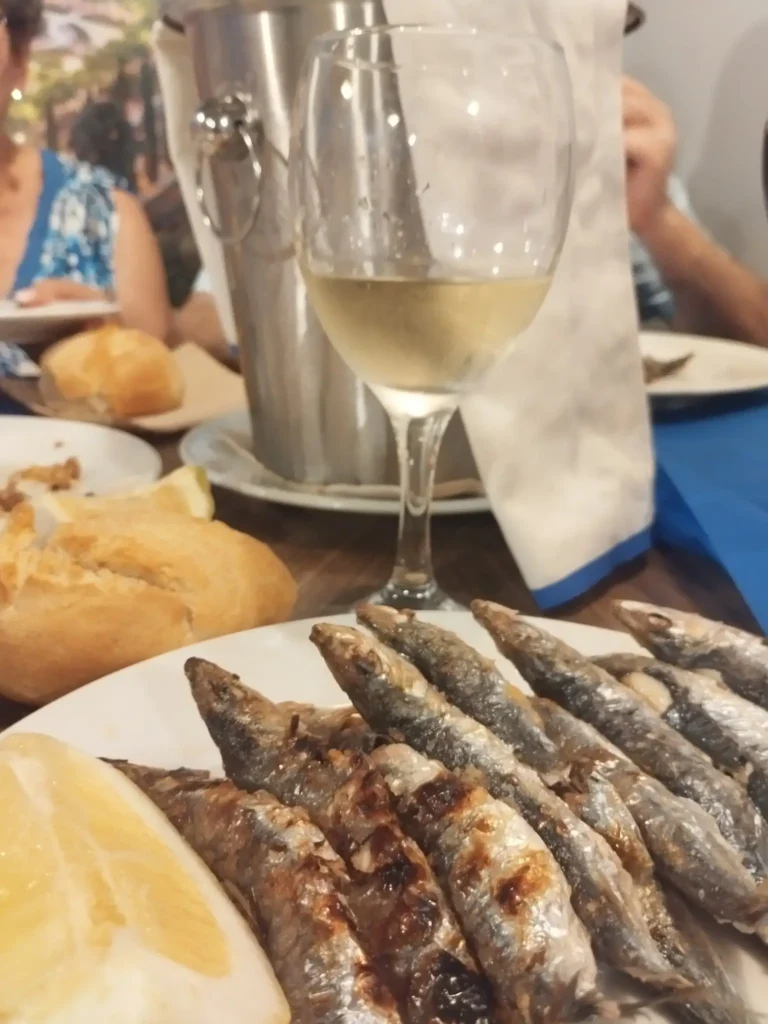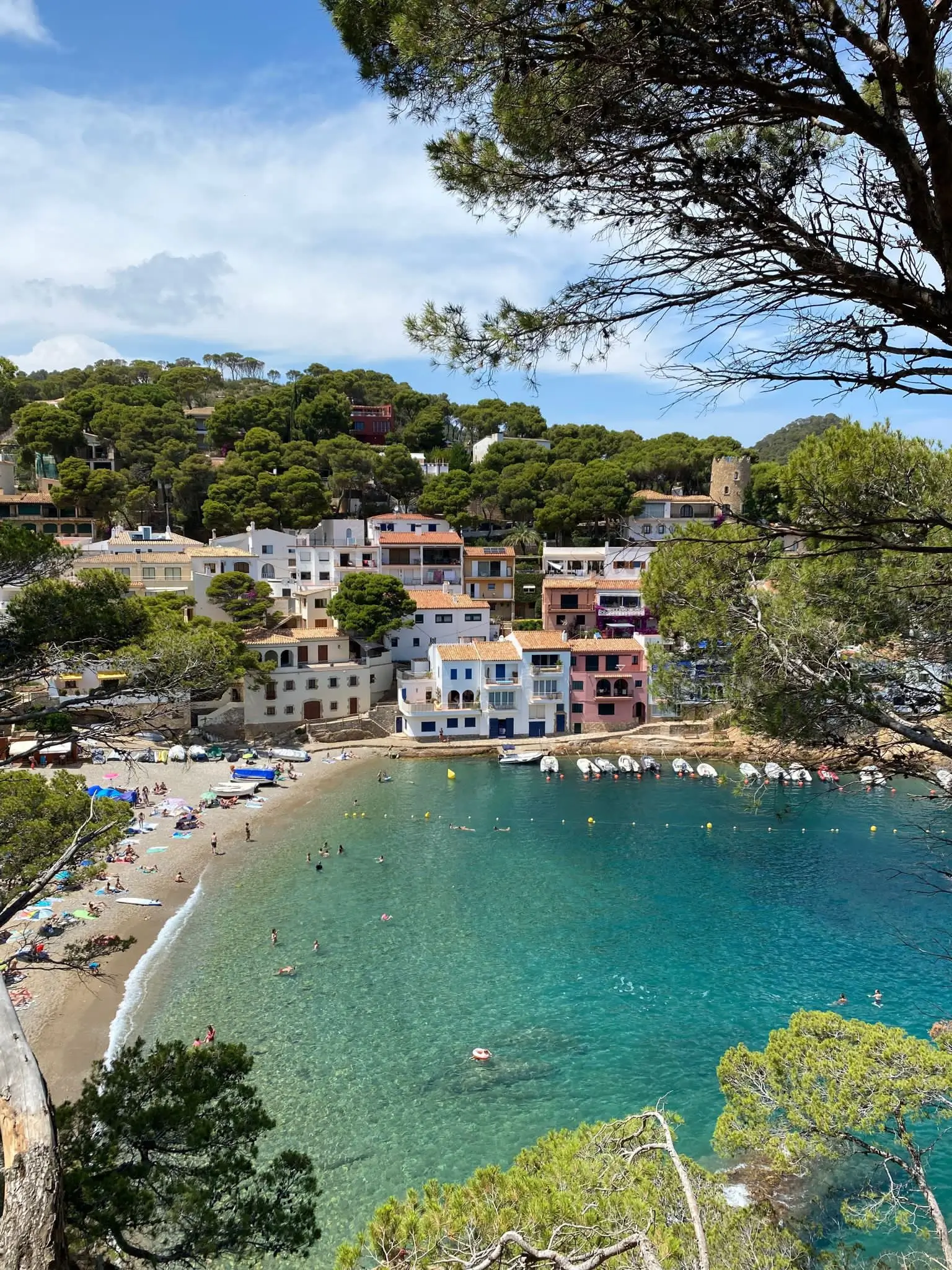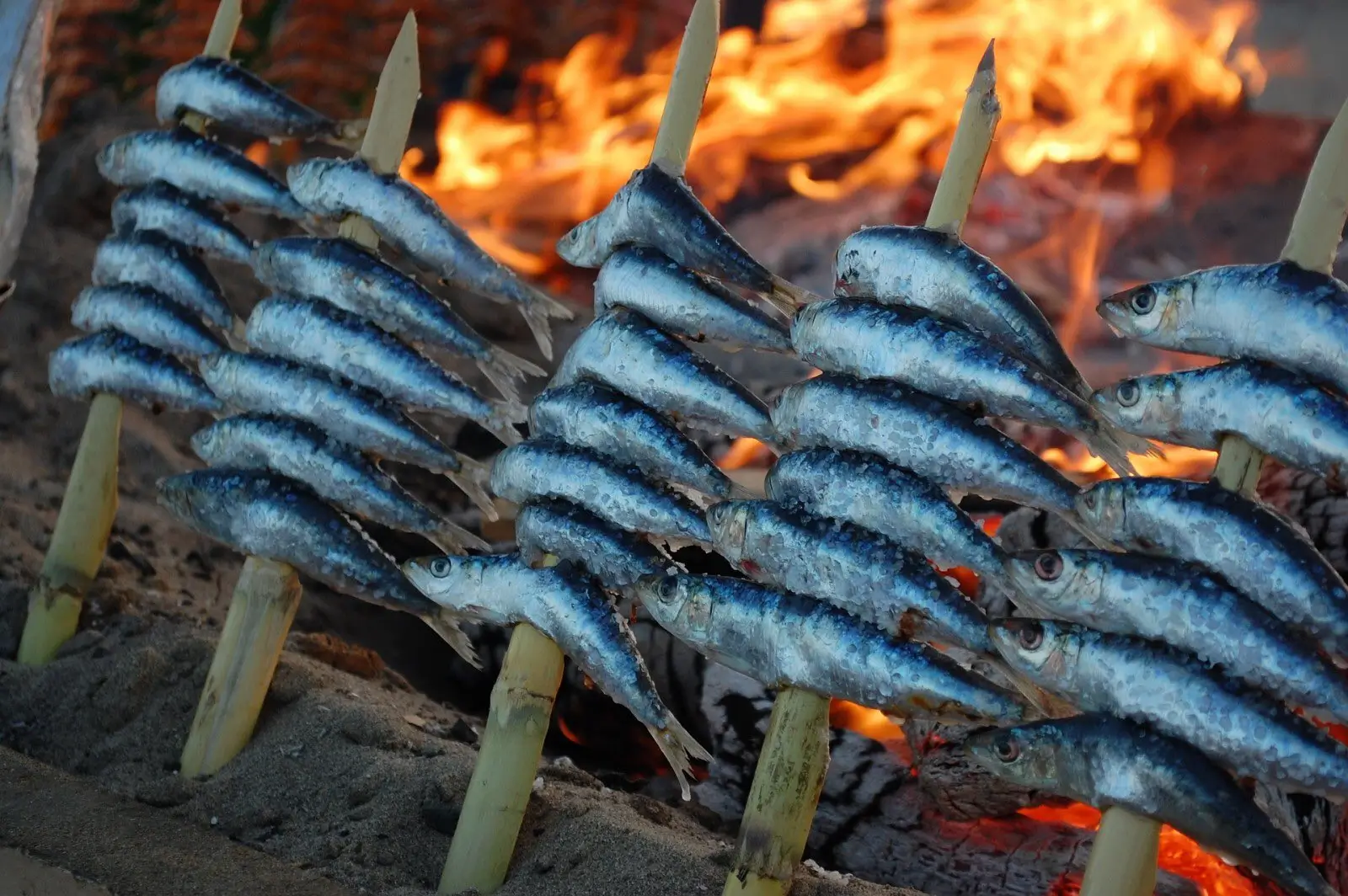Málaga, the city of the Costa del Sol that captivates everyone who visits, has become a sought-after destination for remote workers, particularly those in the tech industry. In recent years, major companies like Google and Amazon have set up hubs in the city, drawn by its ideal climate and high quality of life. In 2023, Málaga was recognized as the second best city in the world for nomadic executives, just behind Dubai.
With its sun-drenched beaches, vibrant nightlife, and undeniable Andalusian charm, this city truly has it all. But beyond its stunning scenery, there’s a culinary treasure you might not have discovered yet: espetos.

What Are Espetos?
An espeto consists of skewering fish, typically sardines, on long, thin canes that are then placed next to a wood fire on the beach.
The gentle heat from the embers slowly cooks the sardines until their skin becomes crispy and their flesh, juicy.
But what truly sets espetos apart is the context: they’re prepared on boats anchored in the sand, with the aroma of sea salt and wood filling the air. Eating an espeto means savoring a piece of Málaga’s culture.
A Journey Through History
Although today espetos are an iconic symbol of Málaga, their origins date back to the 19th century. Legend has it that in 1882, a fisherman named Miguel Martínez Soler had a brilliant idea: to skewer sardines on canes and roast them on the beach. He did this in the neighborhood of El Palo, which at that time was a small fishing village.
This simple invention quickly became a local phenomenon, and the espeto became part of the daily life of the humble folks in the area. What started as a quick and inexpensive meal is now a delicacy loved by both locals and tourists visiting the Costa del Sol.
This tradition has taken such root that a statue was erected in honor of espeteros along the Paseo Marítimo de Antonio Machado, next to Playa de la Misericordia. Yes, the craft of roasting fish on canes has become so revered that it even has its own monument.

When Is the Best Time to Eat Espetos?
Locals in Málaga follow a simple but tasty rule: eat espetos during the months without an “R” in their name—that is, May through August.
Why? Because that’s when sardines are at their best:
- Fattier and juicier due to higher plankton levels in warm waters
- Perfect texture and flavor for grilling over open fire
- Commonly enjoyed during long summer evenings by the sea
This coastal tradition is not only cultural—it also makes culinary sense. Many beach bars even stop offering sardine espetos in winter months, respecting the seasonal cycle and the sustainability of local fishing.
If you’re planning a trip to Málaga, early summer is the perfect time to enjoy this unique local delicacy at its peak.

How Espetos Are Made
At first glance, grilling sardines may seem straightforward, but espeteros master a technique that transforms this process into something much more refined. First, they select fresh sardines, carefully skewering them through their backs on long canes. The secret lies in how the sardines are positioned: they must be perfectly aligned so the heat from the embers cooks them evenly.
The embers are key. Traditionally, olive wood is used, which not only generates the necessary heat but also adds a subtle smoky flavor to the fish. The canes are placed at an angle to allow the espeto to cook with the wind at their back, preventing the fish from becoming overly smoky.
The result is spectacular: sardines with a crispy skin that melts in your mouth and juicy flesh bursting with ocean flavor. All this takes about ten minutes.
Did you know?
The word “espeto” comes from the Latin spatula, meaning “flat piece of wood or stick.” Fishermen along the Málaga coast used this method for centuries to cook their catch right on the beach, long before tourism arrived.
Today, this humble cooking style is considered part of Málaga’s cultural identity—and is even being proposed for UNESCO’s Intangible Cultural Heritage list.
What Makes the Espeto Special?
While you might think that espetos are just “grilled sardines,” the reality is that this method of roasting has a unique charm. Compared to traditional barbecues known in the United States, the espeto offers a much more rustic and direct experience. There are no complicated sauces or dressings—just the fish, the fire, and a sprinkle of salt.
Plus, sardines are incredibly healthy. Packed with omega-3 fatty acids, protein, and vitamins, espetos are not only delicious but also a nutritious choice for your heart.


The Ritual of Eating Espetos
Eating espetos is an informal and relaxed experience, much like the lifestyle on the Costa del Sol. Tradition dictates that you eat them by hand. You grab the sardine by the head or tail and pull the flesh away from the bones with your teeth, leaving the bones intact. A squeeze of lemon on top, and you’ve got the perfect dish.
And of course, the ideal drink to accompany your espetos is something cold: a chilled beer, a glass of white wine, or a tinto de verano are perfect pairings for this delicacy. If you add a fresh salad of tomato, lettuce, and onion, you’ll be in paradise.
Where to Try the Best Espetos
Here are some of the most recommended beach bars (chiringuitos), praised by locals, chefs, and recent culinary contests:
Recommended Chiringuitos:
- El Tintero (Pedregalejo)
A Málaga classic. Known for its lively auction-style service—waiters shout out dishes as they pass by. Expect juicy espetos, lots of locals, and a fun, chaotic vibe.
📍 Pedregalejo
💰 Price: €6–8 - El Caleño (Pedregalejo)
One of the area’s most reliable spots for espetos. Friendly service, fresh fish, and a great terrace for sunset views.
📍 Pedregalejo
💰 Price: €6–9 - Narval (El Palo)
A hidden gem famous for grilling over 1,000 espetos a day—at just €2 each! Traditional and affordable, it’s a favorite among locals.
📍 El Palo
💰 Price: €2
⭐️ Local legend - Miguelito El Cariñoso (El Palo)
Highlighted by TasteAtlas and national media. Grilled sardines are the star, but don’t miss the fried fish either.
📍 El Palo
💰 Price: €5–7
Additionally, while sardines are the traditional fish, you’ll also find espetos made with other varieties like doradas, lubinas, or even calamari.

🐟 Local Tip: The Best Espetos Are in El Palo and La Araña
Looking for the most authentic espetos in Málaga? Ask any local, and they’ll point you to El Palo or La Araña, two traditional fishing neighborhoods east of the city. Here, sardines are grilled daily just meters from the sea—no frills, just real flavor.
In El Palo:
- El Espigón de Pepe – A no-nonsense favorite with sardines cooked to perfection
- Narval – Famous for grilling over 1,000 espetos a day at unbeatable prices
In La Araña:
- Chiringuito Antonio Moreno – Rustic, humble, and unbeatable value
- Ponte Puó – A true neighborhood gem with spectacular views and flavor
If you want to eat like a malagueño, skip the tourist beachfront and head east.
Best espetos in Málaga City and Surroundings
Chiringuito María (La Misericordia Beach)
Frequently appears in local rankings. Simple, honest cooking and beachfront location make it a safe bet.
📍 Málaga – Playa de la Misericordia
💰 Price: €6–7
Trocadero Casa de Botes (Port of Málaga)
A more upscale setting with excellent quality fish and impeccable service.
📍 Málaga Port
💰 Price: €10+
🍷 Great wine list
Marina Playa (Málaga West)
Winner of the 2023 Espeto Route award. Casual and relaxed, ideal for lunch by the sand.
📍 Málaga West (Sacaba Beach)
🏆 Award-winning espetero
A Treasure Waiting to Be Recognized
Despite their long history and popularity among locals and tourists, espetos have yet to receive the global recognition they deserve. For several years, efforts have been underway to have UNESCO declare them an Intangible Cultural Heritage of Humanity. It’s not just about taste, but also about technique, tradition, and culture. However, the process is still ongoing, so in the meantime, you have the chance to enjoy this culinary treasure before it becomes a worldwide phenomenon.
More Than Just a Dish, It’s an Experience
The espeto is much more than a way to cook fish. It’s an experience that captures the laid-back and authentic lifestyle of Málaga. By trying it, you’re not just savoring a delicious meal; you’re participating in a centuries-old tradition that’s part of the cultural identity of southern Spain.

🍖 Curious about more iconic Spanish flavors?
Discover why Iberian ham is not just a delicacy, but a ritual in Mediterranean life.
Espeto FAQ: Common Questions About Málaga’s Most Iconic Dish
What is an espeto?
An espeto is a traditional way of cooking sardines in Málaga, Spain. The fish are skewered on long canes and grilled over wood fire on the beach, often using sand-anchored boats. It’s a centuries-old technique that reflects Andalusian coastal heritage.
Where can I eat the best espetos in Málaga?
The best places to enjoy espetos are local chiringuitos along beaches like El Palo, Pedregalejo, and Playa de la Misericordia. Some top spots include El Tintero, La Moraga, and Chiringuito La Playa.
When is the best time to eat espetos?
Espetos are especially popular in summer, from June to early September. The best time of day to enjoy them is during lunch or at sunset, freshly grilled by the sea.
Are espetos healthy?
Yes, espetos are a healthy option. Sardines are rich in omega-3 fatty acids, protein, and essential vitamins. Grilling them over wood fire without sauces preserves their nutritional value.
Can I make espetos at home?
While traditional espetos require beach sand and wood fire, you can replicate them at home using fresh sardines, skewers, and a charcoal grill. The key is to cook them simply, with salt and direct heat.
Are espetos only made with sardines?
Sardines are the classic, but some chiringuitos also prepare espetos with other fish like mackerel or sea bream.

Spanish Latte Recipe: Mediterranean Coffee Tradition Meets Modern Café Culture

Costa Brava Without the Crowds: Peaceful Towns, Coastal Trails, and Honest Local Tips

What Is a Mediterranean Aperitivo? Meaning, Food and Ritual


